1 Nowadays with the rapid development of advanced
- 格式:doc
- 大小:30.50 KB
- 文档页数:4
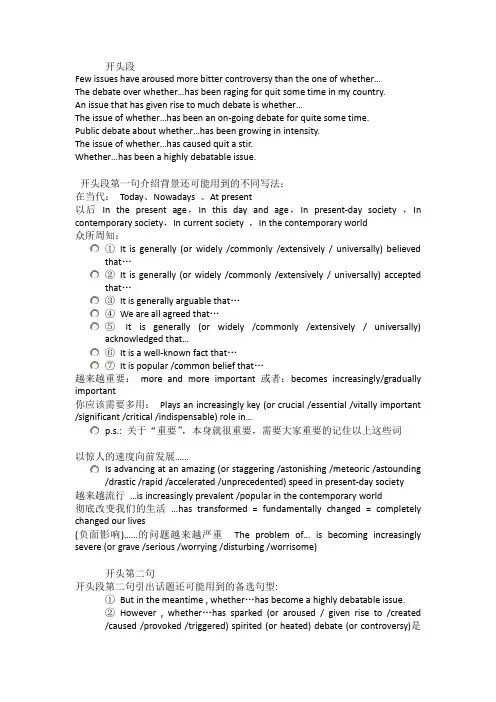
开头段Few issues have aroused more bitter controversy than the one of whether…The debate over whether…has been raging for quit some time in my country.An issue that has given rise to much debate is whether…The issue of whether…has been an on-going debate for quite some time.Public debate about whether…has been growing in intensity.The issue of whether…has caused quit a stir.Whether…has been a highly debatable issue.开头段第一句介绍背景还可能用到的不同写法:在当代:Today、Nowadays 、At present以后In the present age,In this day and age,In present-day society ,In contemporary society,In current society ,In the contemporary world众所周知:①It is generally (or widely /commonly /extensively / universally) believedthat…②It is generally (or widely /commonly /extensively / universally) acceptedthat…③It is generally arguable that…④We are all agreed that…⑤It is generally (or widely /commonly /extensively / universally)acknowledged that…⑥It is a well-known fact that…⑦It is popular /common belief that…越来越重要:more and more important或者:becomes increasingly/gradually important你应该需要多用:Plays an increasingly key (or crucial /essential /vitally important /significant /critical /indispensable) role in…p.s.: 关于“重要”,本身就很重要,需要大家重要的记住以上这些词以惊人的速度向前发展……Is advancing at an amazing (or staggering /astonishing /meteoric /astounding/drastic /rapid /accelerated /unprecedented) speed in present-day society越来越流行…is increasingly prevalent /popular in the contemporary world彻底改变我们的生活…has transformed = fundamentally ch anged = completely changed our lives(负面影响)……的问题越来越严重The problem of… is becoming increasingly severe (or grave /serious /worrying /disturbing /worrisome)开头第二句开头段第二句引出话题还可能用到的备选句型:①But in the meantime , whether…has become a highly debatable issue.②However , whether…has sparked (or aroused / given rise to /created/caused /provoked /triggered) spirited (or heated) debate (or controversy)是否……这个问题不同的人持不同的看法。
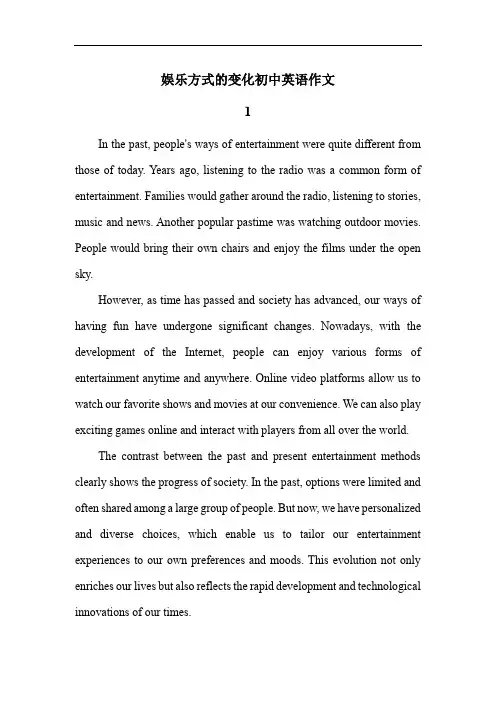
娱乐方式的变化初中英语作文1In the past, people's ways of entertainment were quite different from those of today. Years ago, listening to the radio was a common form of entertainment. Families would gather around the radio, listening to stories, music and news. Another popular pastime was watching outdoor movies. People would bring their own chairs and enjoy the films under the open sky.However, as time has passed and society has advanced, our ways of having fun have undergone significant changes. Nowadays, with the development of the Internet, people can enjoy various forms of entertainment anytime and anywhere. Online video platforms allow us to watch our favorite shows and movies at our convenience. We can also play exciting games online and interact with players from all over the world.The contrast between the past and present entertainment methods clearly shows the progress of society. In the past, options were limited and often shared among a large group of people. But now, we have personalized and diverse choices, which enable us to tailor our entertainment experiences to our own preferences and moods. This evolution not only enriches our lives but also reflects the rapid development and technological innovations of our times.In today's rapidly evolving world, the ways we entertain ourselves have undergone remarkable changes, profoundly influencing our lives. The prevalence of smartphones has been a game-changer. Social entertainment apps have made it incredibly easy for us to stay connected with friends and share joys. No matter where we are, with just a few taps on the screen, we can exchange messages, share photos, and even have video calls, bridging the distances and keeping our friendships alive and vibrant.The advent of virtual reality technology has also brought about a revolutionary shift in entertainment. It offers us a completely new and immersive experience. We can step into virtual worlds, explore uncharted territories, and engage in adventures that were once only imaginable. For instance, we can virtually visit historical sites, experience extreme sports, or even battle in fantasy realms, all from the comfort of our homes.These changes in entertainment methods not only provide us with more choices and conveniences but also have a significant impact on our social interactions and ways of learning. However, they also bring some challenges. For example, excessive reliance on digital entertainment may lead to less face-to-face communication and a decrease in outdoor activities. Therefore, while enjoying the benefits of these changes, we should also be mindful of maintaining a balanced and healthy lifestyle.In today's rapidly changing world, the ways people entertain themselves have undergone significant transformations. The main reasons behind these changes are the astonishing advancements in technology and the improvement of people's living standards.The rapid development of technology has been a key driver. Electronic products are constantly being upgraded and replaced. Smartphones, for instance, have become indispensable companions for many. They offer not only communication but also a plethora of entertainment options such as games, videos, and social media. The internet has connected people globally, allowing for easy access to various forms of entertainment.Moreover, as people's living standards rise, their demands and pursuits for entertainment have also increased. They no longer satisfy with simple and repetitive forms of entertainment. Instead, they look for more diverse, personalized, and high-quality experiences. For example, traveling has become a popular choice for many to relax and broaden their horizons. Cultural activities like attending concerts, visiting art exhibitions, and participating in sports events have also gained popularity.In conclusion, the changes in entertainment methods are the result of the combined effects of technological progress and the improvement of people's living conditions. These changes have brought more choices andpleasures to our lives, while also constantly challenging us to keep up with the times and embrace new ways of having fun.4In recent years, the ways of entertainment have undergone significant changes. Looking forward, it's not hard to predict that the future of entertainment will continue to evolve in fascinating ways.With the rapid development of artificial intelligence, we can expect more personalized and intelligent entertainment projects. Imagine a virtual reality game that adjusts its difficulty and storyline based on your emotions and reactions in real time. Or a movie that tailors its ending based on your preferences during the viewing process. This level of customization and interactivity will bring a whole new dimension to our entertainment experiences.Moreover, as environmental awareness grows stronger, green entertainment methods will gain more attention. Outdoor activities that are environmentally friendly, such as nature walks and eco-friendly sports, will become increasingly popular. People will seek entertainment that not only brings joy but also has a positive impact on the environment.In addition, the integration of technology and traditional forms of entertainment will also be a notable trend. For instance, traditional stage performances might incorporate holographic projections and augmented reality to create more immersive experiences for the audience.In conclusion, the future of entertainment holds endless possibilities. We are on the cusp of a new era where entertainment will be more personalized, environmentally friendly, and technologically advanced, providing us with countless exciting and unique experiences.5In recent years, the ways of entertainment have undergone significant changes. These changes have brought both advantages and disadvantages to our lives.Take video games for example. They offer us great pleasure and entertainment, allowing us to enter virtual worlds and experience various adventures. However, they can also lead to addiction if not controlled properly. Many teenagers spend excessive time on video games, neglecting their studies and physical activities.Another example is online socializing. It enriches our lives by enabling us to connect with people from different places and share our thoughts and experiences. But at the same time, it reduces the frequency of face-to-face communication. We may lose the ability to have in-depth and sincere conversations with others in person.The changes in entertainment have indeed made our lives more colorful and convenient. But we need to be aware of the potential problems and use these new forms of entertainment in a reasonable way. Only in this way can we truly enjoy the benefits they bring while avoiding the negativeimpacts.。
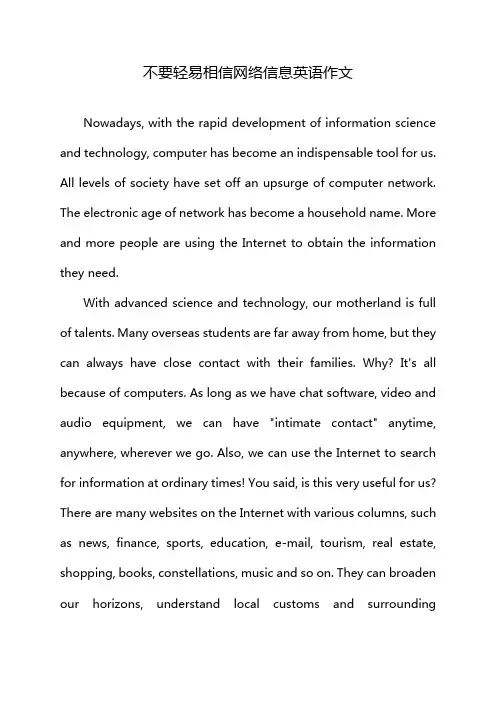
不要轻易相信网络信息英语作文Nowadays, with the rapid development of information science and technology, computer has become an indispensable tool for us. All levels of society have set off an upsurge of computer network. The electronic age of network has become a household name. More and more people are using the Internet to obtain the information they need.With advanced science and technology, our motherland is full of talents. Many overseas students are far away from home, but they can always have close contact with their families. Why? It's all because of computers. As long as we have chat software, video and audio equipment, we can have "intimate contact" anytime, anywhere, wherever we go. Also, we can use the Internet to search for information at ordinary times! You said, is this very useful for us? There are many websites on the Internet with various columns, such as news, finance, sports, education, e-mail, tourism, real estate, shopping, books, constellations, music and so on. They can broaden our horizons, understand local customs and surroundingenvironment. You say that the Internet is so difficult that it doesn't look like a versatile doctor?Of course, the Internet is not all good. It also has a bad side. Some illegal websites are full of violence, pornography and other bad information, eroding people's body and poisoning people's spirit. In fact, many juvenile delinquents who committed crimes of coercion and prostitution were initially influenced by obscene books, CDs and illegal websites. Teenagers have strong curiosity, but their ability to distinguish right from wrong and good from evil is weak. If they are not careful, they will be tempted and pay a heavy price. Therefore, we should keep away from these bad temptations.Some are not because of illegal websites, but because of chatting. A girl from a school got to know a net friend while chatting on the Internet. The man claimed to be "a sister who likes reality". The two became "bosom friends" after a short time of communication. The girl met him alone because she trusted her online "friend". When we met, we learned that the "sister" was an adult man. After the girl knew that she had been cheated, she was too late to repent. The man forced violence, which was a serioustrauma to the girl's soul. It can be seen from this that you can't trust netizens, otherwise you will only outsmart yourself.These examples all illustrate the same truth: we can't easily trust the Internet. Although it has a good side, we still need to be on guard.Let's learn to surf the Internet green and embrace the world!。
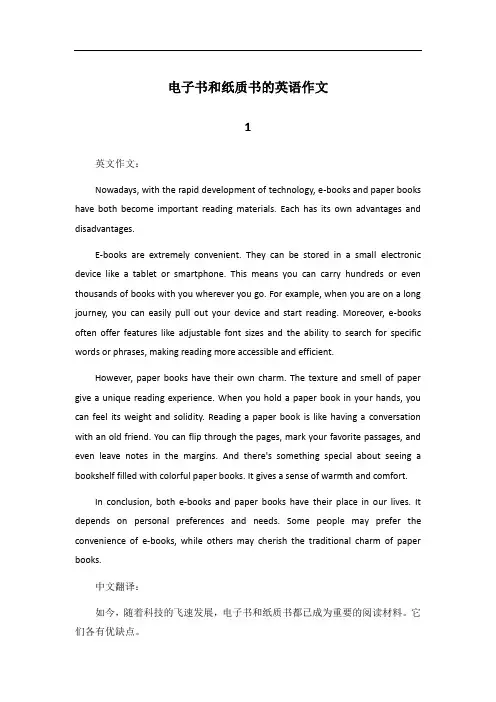
电子书和纸质书的英语作文1英文作文:Nowadays, with the rapid development of technology, e-books and paper books have both become important reading materials. Each has its own advantages and disadvantages.E-books are extremely convenient. They can be stored in a small electronic device like a tablet or smartphone. This means you can carry hundreds or even thousands of books with you wherever you go. For example, when you are on a long journey, you can easily pull out your device and start reading. Moreover, e-books often offer features like adjustable font sizes and the ability to search for specific words or phrases, making reading more accessible and efficient.However, paper books have their own charm. The texture and smell of paper give a unique reading experience. When you hold a paper book in your hands, you can feel its weight and solidity. Reading a paper book is like having a conversation with an old friend. You can flip through the pages, mark your favorite passages, and even leave notes in the margins. And there's something special about seeing a bookshelf filled with colorful paper books. It gives a sense of warmth and comfort.In conclusion, both e-books and paper books have their place in our lives. It depends on personal preferences and needs. Some people may prefer the convenience of e-books, while others may cherish the traditional charm of paper books.中文翻译:如今,随着科技的飞速发展,电子书和纸质书都已成为重要的阅读材料。
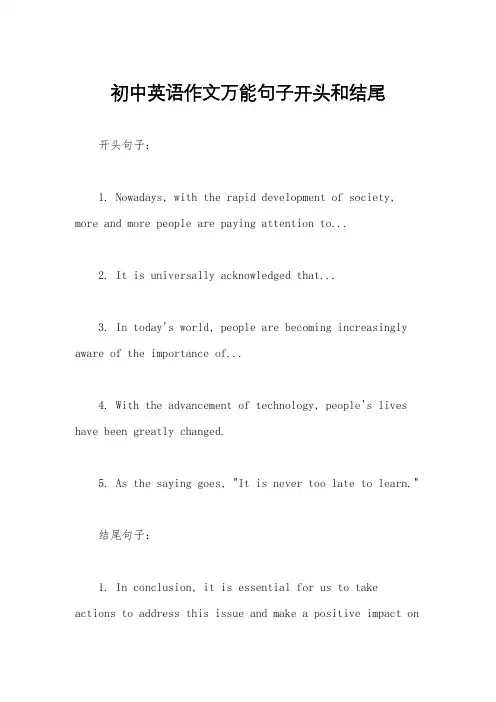
初中英语作文万能句子开头和结尾开头句子:1. Nowadays, with the rapid development of society, more and more people are paying attention to...2. It is universally acknowledged that...3. In today's world, people are becoming increasingly aware of the importance of...4. With the advancement of technology, people's lives have been greatly changed.5. As the saying goes, "It is never too late to learn."结尾句子:1. In conclusion, it is essential for us to take actions to address this issue and make a positive impact onthe world.2. In a word, we should make every effort to contribute to a better future for our planet.3. To sum up, it is high time for us to realize the significance of this issue and take immediate actions.4. In the light of the above discussion, I firmly believe that we can make a difference if we work together.5. In the long run, our efforts will surely pay off and lead to a more sustainable and prosperous world for future generations.仿写范文:Nowadays, with the rapid development of society, more and more people are paying attention to the issue of environmental protection. It is universally acknowledged that the environment plays a crucial role in our lives and the well-being of future generations. In today's world,people are becoming increasingly aware of the importance of preserving the environment and taking action to address environmental issues. With the advancement of technology, people's lives have been greatly changed, and it is high time for us to realize the significance of this issue and take immediate actions.In recent years, the issue of environmental protection has gained widespread attention and has become a global concern. The rapid industrialization and urbanization have led to environmental degradation, including air and water pollution, deforestation, and the depletion of natural resources. It is evident that these environmental problems have a direct impact on human health and the overallquality of life. Therefore, it is essential for us to take actions to address this issue and make a positive impact on the world.In a word, we should make every effort to contribute to a better future for our planet. It is never too late to learn and take action to protect the environment. In the light of the above discussion, I firmly believe that we canmake a difference if we work together. Our efforts will surely pay off and lead to a more sustainable and prosperous world for future generations. Let's join hands and make a positive impact on the environment for the well-being of all living beings.。
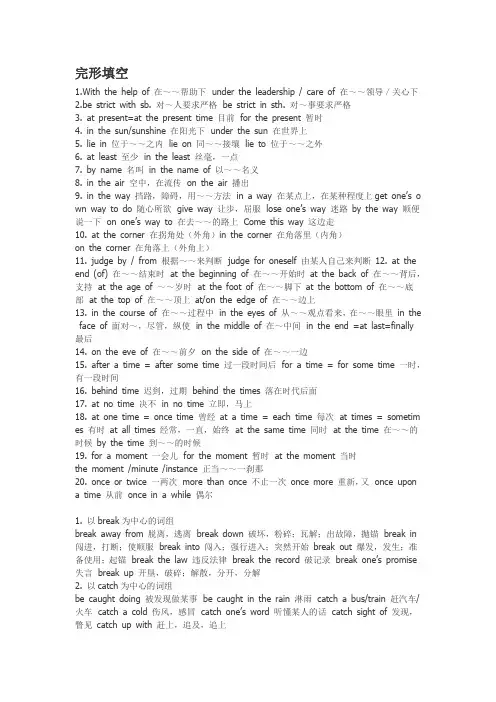
完形填空1.With the help of 在~~帮助下 under the leadership / care of 在~~领导/关心下2.be strict with sb. 对~人要求严格 be strict in sth. 对~事要求严格3. at present=at the present time 目前 for the present 暂时4. in the sun/sunshine 在阳光下 under the sun 在世界上5. lie in 位于~~之内 lie on 同~~接壤 lie to 位于~~之外6. at least 至少 in the least 丝毫,一点7. by name 名叫 in the name of 以~~名义8. in the air 空中,在流传 on the air 播出9. in the way 挡路,障碍,用~~方法 in a way 在某点上,在某种程度上get one’s o wn way to do 随心所欲 give way 让步,屈服lose one’s way 迷路by the way 顺便说一下on one’s way to 在去~~的路上 Come this way 这边走10. at the corner 在拐角处(外角)in the corner 在角落里(内角)on the corner 在角落上(外角上)11. judge by / from 根据~~来判断 judge for oneself 由某人自己来判断12. at the end (of) 在~~结束时 at the beginning of 在~~开始时at the back of 在~~背后,支持 at the age of ~~岁时 at the foot of 在~~脚下at the bottom of 在~~底部 at the top of 在~~顶上at/on the edge of 在~~边上13. in the course of 在~~过程中 in the eyes of 从~~观点看来,在~~眼里in the face of 面对~,尽管,纵使 in the middle of 在~中间 in the end =at last=finally 最后14. on the eve of 在~~前夕 on the side of 在~~一边15. after a time = after some time 过一段时间后 for a time = for some time 一时,有一段时间16. behind time 迟到,过期 behind the times 落在时代后面17. at no time 决不 in no time 立即,马上18. at one time = once time 曾经at a time = each time 每次 at times = sometim es 有时at all times 经常,一直,始终 at the same time 同时 at the time 在~~的时候by the time 到~~的时候19. for a moment 一会儿 for the moment 暂时 at the moment 当时the moment /minute /instance 正当~~一刹那20. once or twice 一两次 more than once 不止一次once more 重新,又 once upona time 从前 once in a while 偶尔1. 以break为中心的词组break away from 脱离,逃离 break down 破坏,粉碎;瓦解;出故障,抛锚 break in 闯进,打断;使顺服 break into 闯入;强行进入;突然开始break out 爆发,发生;准备使用;起锚 break the law 违反法律 break the record 破记录break one’s promise 失言 break up 开垦,破碎;解散,分开,分解2. 以catch为中心的词组be caught doing 被发现做某事 be caught in the rain 淋雨 catch a bus/train 赶汽车/火车 catch a cold 伤风,感冒catch one’s word 听懂某人的话 catch sight of 发现,瞥见catch up with 赶上,追及,追上3. 以come为中心的词组come across 偶尔发现,想起;越过;偿付 come along 一道来,陪伴;进步,进展;出现come at 达到,求得,得到;扑向,袭击 come back 回来;恢复,复原come down 倒下;降落;跌落;病倒 come from 来自,起源于,从~~产生,生于come in 进来,进入;流行起来;获名次 come into being 发生,产生,出现,形成come into power 开始执政,当权,当选 come into use 开始使用,获得应用come on 上演;开始;赶快;发展;登台;(问题)被提出come to know 开始了解到come out 出来,传出;出版;结果是;褪色;(秘密)泄露come to 苏醒,复原;共计;达到;归结于 come to an end 终止,结束come true 实现,成为现实;证实 come up 走近;上楼;长出,发芽4. 以do为中心的词组be done in 精疲力竭 be done with 完全结束 do a good deed 做一件好事do away with 去掉,废除;弄死;浪费 do good to (=do sb. good) 有益于do harm to (=do sb. good) 有害于 do its work 有效,有作用 do much 极有用do wrong to 做错do one’s best 尽某人最大努力do one’s homework 做作业do one’s utmost 尽力而为 do proud 足以使~~骄傲 do sb. justice 公平对待某人do some cleaning (V+ing,etc.) 搞卫生 do sb. a favor 帮助某人do well in 学得不错,干得漂亮 do with 和~~相处,忍受,处理 do without 不需要,不用 do wonders 创造奇迹 have much to do with 和~~很有关系 have nothing to d o with 与~~无关have something to do with 和~~有关 in doing so=in so doing 这时,在这种情况下That will do. 行了;够了5. 以get为中心的词组get about 徘徊,走动,旅行;流传 get above oneself 自视高傲 get accustomed to习惯于,对~~习以为常 get across 度过,通过,横过;说服,使理解get ahead of 胜过,超过 get along 前进,进步;同意;离去get along with 与~~相处 get at 发现,了解;掌握;攻击have got to do 不得不,必须get away 离开,逃脱 get back 取回,回来;报复 get behind 落后;识破 get dow n 咽下;写下;使沮丧,使抑郁 get down to 认真对待,静下心来 get familiar with 熟悉 get hold of 获得,取得 get home 到家 get in 进入,陷入;牵涉get off 送走;脱下(衣服);下车;动身 get on 上车;穿上;进步,使前进;成功;相处get upon wit h 进步;在~~方面获得成功get one’s hand in 熟悉;习惯get out of 由~~出来,从~ ~得出;避免;退休 get over 越过;恢复,痊愈;克服;完成get ready for 为~~作准备 get rid of 除去,去掉;免除,摆脱 get through 到达,完成,通过;及格 get toge ther 积聚,积累;商谈,取得一致意见 get up 起床,起立;研究,钻研;致力于;安排,组织 get used to 习惯于6. 以give为中心的词组be given to 沉溺于,癖好 give about 分配;传播 give and take 相互迁就give away 赠送;牺牲;泄露;颁发 give back 归还 give cause 给予~~的理由give e ar to 侧耳倾听 give forth 发出,放出;发表 give in 屈服,让步,投降give in to 同意,接受;向~~让步 give off 发出(烟,气味) give oneself out to be/as 自称为give on eself up to 专心于;向~~自首 give out 分发,公布 give place to 让位于,被~~所替代 give rise to 引起,导致;使~~发生 give sb. to understand 通知某人 give up 放弃;停止 give way to 让步,退却;屈服于7. 以look为中心的词组look about 四下环顾;查看 look after 照顾,看管 look around 东张西望look at 注视,着眼于 look back 回顾 look for 寻找;期待,期望 look down on 俯视;轻视 look for ward to 盼望,期待look into 窥视;调查;浏览 look like 看起来象 look on 旁观;面向look out 向外看;注意;当心,堤防 look over 从上面看过去;检查look through透过~~看去;看穿;浏览 look up to 仰望,尊敬8. 以make为中心的词组be made from 由~~原料制成 be made of 由~~材料制成 be made up of 由~~组成make a fool of 愚弄,欺骗 make a mistake 弄错 make a point of doing 强调;认为~~重要;决心,坚持 make advantages/use of 使用,利用 make after 追求,追赶 ma ke believe 假装 make certain 确信,把~~弄清楚make contact with 接通,与~~接触,与~~联系 make for 去向,向~~前进;有利于make friends with 和~~交友 make int o 把~~制成,使~~转变为 make much of 重视;理解;赏识make one’s mind on sth.决定某事make one’s own 当作自己的看待 make oneself at home 随便,别拘束 ma ke out 填写;开支票;理解;辨认 make the best of 尽量利用;极为重视make up 弥补,修理;赔偿,补偿;起草;编造;化装 make up to 接近,巴结;向~~求爱 make way for 为~~让路,让路于 on the make 急求成功;增加9. 以put为中心的词组put aside 把~~放在一边;搁置;排除 put away 把~~放好,把~~收拾;储藏;吃喝,吃掉put back 把~~放回原处;驳回 put down 放下;镇压;制止;记下;削减;降落put forward 提出;拨快;建议,推荐;提倡,倡议 put ~~ into 把~~放入;插入;翻译成put off 推迟,延期;消除;推脱,推辞 put on 上演;穿上,带上put up with 忍受,容忍put one’s heart into 全神贯注,专心致志 put up 举起,挂起;提名,推荐;陈列10. 以take为中心的词组be taken aback 吃惊 take a seat 就坐 take a shower 淋浴,洗澡 take aim 瞄准,设立目标 take away 拿走,减去;夺去 take ~~ by surprise 出奇制胜take one’s place 就坐,入坐take care of 当心,注意;照顾;提防;谨慎;处理,对付;负责take offic e 就职,上任 take ~~ for 把~当作take off 脱去,除去;离开;起飞;模仿;起程;致死;复制,作副本;减弱take one’s temperature 量体温 take part in 参与,参加take it easy 别着急,慢慢来take place = happen 发生,举行 take the place of 代替tak e pride in 以~~为荣,对~~骄傲 take sb. by the arm 拉某人的胳膊11. 以turn为中心的词组give a new turn to 对~~予以新的看法in one’s turn 轮到某人做某事out of turn 不按次序的,不合适宜的take one’s turn to do 轮到做turn a blind eye to 对~~视而不见 turn against 背叛,采取敌对态度turn back 折回,往回走 turn down 折叠,翻下,驳回,拒绝考虑turn into 走进;变成,变为 turn to ~~for help 求助于turn off 关上(自来水,电器开关);解雇,辞退;避开(问题);制造;生产turn on 打开(自来水,电器开关);反对;依靠,依赖,取决于turn one’s attention to 把注意力转向 turn out 培养;证明是;制成;实际情况是turn out to be 原来是,证明是,结果是turn overa new leaf 翻开新的一页,重新开始,改过自新turn (a)round 旋转,转过身来;改变意见;采取新政策turn to 变成;着手于 turn upside down 颠倒过来,翻过来;使陷入混乱六级--------作文-------模板-----------分享•我的分享••当前分享返回分享首页»分享----六级--------作文-------模板-----------记住它,作文接近满分【留着自己用】来源:吴钰赟的日志1)先背3个句子1 Nowadays with the rapid development of advanced ……., more and more…..are commonly and widely us ed in everyday life.(讲重要性)2 The popularity of digital …will have great influence o n our work, study and everyday life. On the one hand …, But on the other hand.(讲影响)3To conclude,…..are just like a double-edged sword. With them we may have less trouble dealing with problems in life and enjoy a better-off life. However, one p oint should be kept in mind that we should take sensi ble use of them , always being the master of them.(结尾段)Ps:灵活运用第1句和第2句,根据不同模板自由组合。
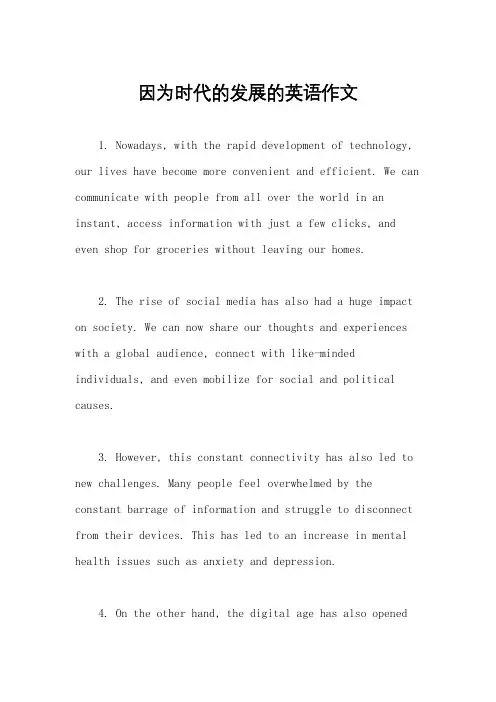
因为时代的发展的英语作文1. Nowadays, with the rapid development of technology, our lives have become more convenient and efficient. We can communicate with people from all over the world in an instant, access information with just a few clicks, and even shop for groceries without leaving our homes.2. The rise of social media has also had a huge impact on society. We can now share our thoughts and experiences with a global audience, connect with like-minded individuals, and even mobilize for social and political causes.3. However, this constant connectivity has also led to new challenges. Many people feel overwhelmed by the constant barrage of information and struggle to disconnect from their devices. This has led to an increase in mental health issues such as anxiety and depression.4. On the other hand, the digital age has also openedup new opportunities for creativity and innovation. Artists, musicians, and writers can now reach a wider audience than ever before, and new forms of expression are constantly emerging.5. In conclusion, the development of technology has brought about both positive and negative changes in our lives. It is important for us to find a balance between the benefits of connectivity and the need for mental well-being. As we continue to adapt to the challenges of the digital age, it is crucial that we prioritize human connection and creativity.。

英语作文现象正反面阐述英文回答:Nowadays, with the rapid development of technology, people are becoming increasingly reliant on their smartphones. On the one hand, this phenomenon has brought about great convenience in our daily lives. For example, we can easily communicate with our friends and family through messaging apps, and we can quickly access information onthe internet. However, on the other hand, this over-reliance on smartphones has also led to negative consequences. Many people are now addicted to their phones, constantly checking for updates on social media and feeling anxious when they are without their devices. This can leadto a lack of real human connection and a decrease in productivity.中文回答:现在,随着科技的快速发展,人们越来越依赖他们的智能手机。
一方面,这种现象给我们的日常生活带来了很大的便利。
例如,我们可以通过消息应用轻松地与朋友和家人交流,也可以快速获取互联网上的信息。
然而,另一方面,对智能手机的过度依赖也带来了负面影响。
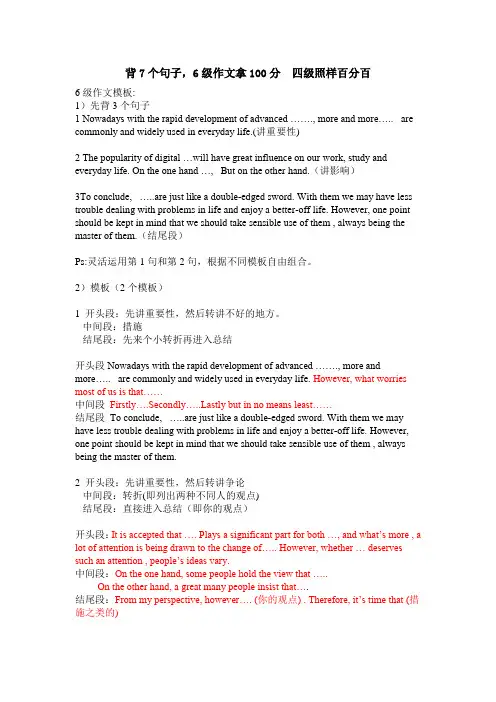
背7个句子,6级作文拿100分四级照样百分百6级作文模板:1)先背3个句子1 Nowadays with the rapid development of advanced ……., more and more…..are commonly and widely used in everyday life.(讲重要性)2 The popularity of digital …will have great influence on our work, study and everyday life. On the one hand …, But on the other hand.(讲影响)3To conclude, …..are just like a double-edged sword. With them we may have less trouble dealing with problems in life and enjoy a better-off life. However, one point should be kept in mind that we should take sensible use of them , always being the master of them.(结尾段)Ps:灵活运用第1句和第2句,根据不同模板自由组合。
2)模板(2个模板)1 开头段:先讲重要性,然后转讲不好的地方。
中间段:措施结尾段:先来个小转折再进入总结开头段Nowadays with the rapid development of advanced ……., more and more…..are commonly and widely used in everyday life. However, what worries most of us is that……中间段Firstly….Secondly…stly but in no means least……结尾段To conclude, …..are just like a double-edged sword. With them we may have less trouble dealing with problems in life and enjoy a better-off life. However, one point should be kept in mind that we should take sensible use of them , always being the master of them.2 开头段:先讲重要性,然后转讲争论中间段:转折(即列出两种不同人的观点)结尾段:直接进入总结(即你的观点)开头段:It is accepted that …. Plays a significant part for both …, and what’s more , a lot of attention is being drawn to the change of….. However, whether … deserves such an attention , people’s ideas vary.中间段:On the one hand, some people hold the view that …..On the other hand, a great many pe ople insist that….结尾段:From my perspective, however…. (你的观点) . Therefore, it’s time that (措施之类的)6级作文万能句子(补充在”…..”里面的万能句子,自己琢磨每个句子放在哪里比较适合)重点背:1)5)6)7)句子,最好全部都被过一遍,自己琢磨怎么用。
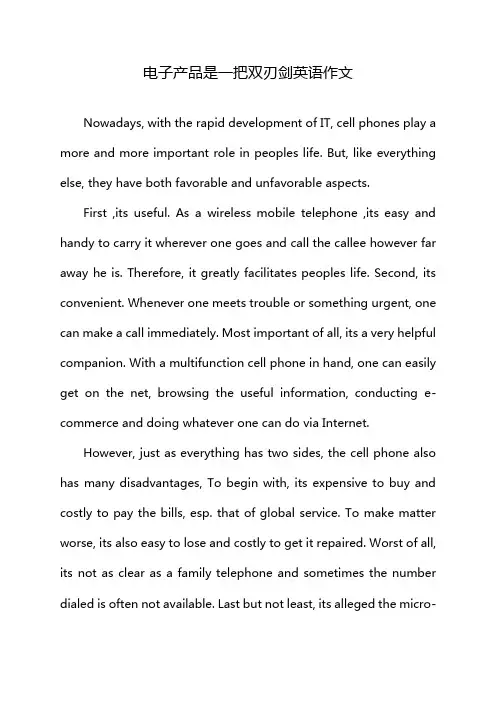
电子产品是一把双刃剑英语作文Nowadays, with the rapid development of IT, cell phones play a more and more important role in peoples life. But, like everything else, they have both favorable and unfavorable aspects.First ,its useful. As a wireless mobile telephone ,its easy and handy to carry it wherever one goes and call the callee however far away he is. Therefore, it greatly facilitates peoples life. Second, its convenient. Whenever one meets trouble or something urgent, one can make a call immediately. Most important of all, its a very helpful companion. With a multifunction cell phone in hand, one can easily get on the net, browsing the useful information, conducting e-commerce and doing whatever one can do via Internet.However, just as everything has two sides, the cell phone also has many disadvantages, To begin with, its expensive to buy and costly to pay the bills, esp. that of global service. To make matter worse, its also easy to lose and costly to get it repaired. Worst of all, its not as clear as a family telephone and sometimes the number dialed is often not available. Last but not least, its alleged the micro-waves in it might do harm to peoples health.In my opinion, with its expenses greatly reduced after Chinas entry into the WTO, Someday most of them will be developed into new Internet-enabled mobile phones, which will be as useful as pocket computers. And I believe its advantages will not only offset its disadvantages, but also far outweigh them.。
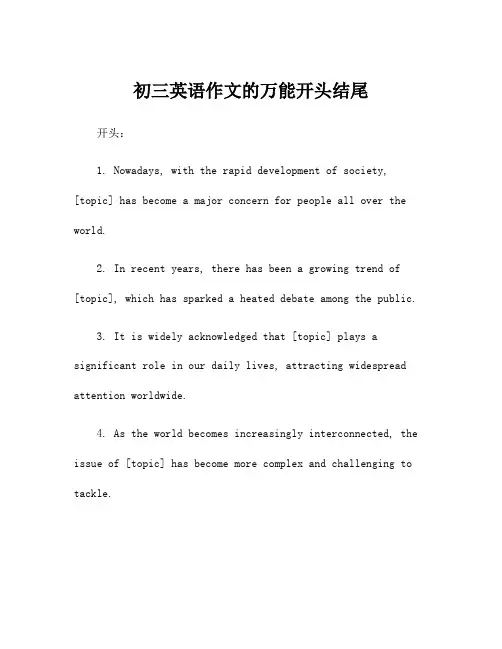
初三英语作文的万能开头结尾开头:1. Nowadays, with the rapid development of society, [topic] has become a major concern for people all over the world.2. In recent years, there has been a growing trend of [topic], which has sparked a heated debate among the public.3. It is widely acknowledged that [topic] plays a significant role in our daily lives, attracting widespread attention worldwide.4. As the world becomes increasingly interconnected, the issue of [topic] has become more complex and challenging to tackle.5. With the advent of advanced technology and globalization, [topic] has emerged as a pressing issue that requires immediate attention.结尾:1. In conclusion, it is evident that [restate the topic] is a multifaceted issue that demands collective efforts from individuals, governments, and international organizations.2. Considering the potential consequences of overlooking or neglecting [topic], it is high time we took concrete actions to address this issue and strive for a better future.3. To sum up, by taking the aforementioned measures and fostering a sense of global awareness, we can pave the way towards a sustainable and harmonious world.4. Only through joint efforts can we hope to overcome the challenges posed by [topic] and create a promising future for all.5. In light of the various aspects discussed, it iscrucial for us to recognize the impact of [topic] and work towards finding innovative solutions to mitigate its negative effects.请注意,以上提供的是开头和结尾的句子范例,且只提供了一部分。
10广播电视新闻1班陈美程2010024102Positive and Negative Effects of the Internet Nowadays,with the rapid development of advanced technology , the Internet are commonly and widely used in our daily life. As is known to all ,the Internet is a double-edged sword ,which including both positive and negative effect.There is no doubt that the Internet has brought many advantage to us.To put it in another way, the Internet can bring convenient to our daily life , speed up the economic development and promote social progress. For example, people can use the Internet to do their business with more enterprise and catch more information,which can do good to our economic.What's more, people can live more comfortable because the Internet can do a large sum of things instead of human being.However ,we can't ingore the negative effects bring by the Internet. Today , more and more teenagers are addicted to computer games day and night , which do harm to their health and study .And what's worse , some people use the Internet to hurt people,which make us can't believe people in the Internet. As far as I'm concerned,we must deeply realize the meaningdouble-edge sword of Internet.The government should carry out some measure to clean the environment of the Internet .At the same time,the Netizens themselves should control the time and the way in using the Internet usefully and correctly.Only in this way can the Internet do good to our life.。
大一英语期末作文大一英语期末作文(精选12篇)在我们平凡的日常里,许多人都有过写作文的经历,对作文都不陌生吧,作文是一种言语活动,具有高度的综合性和创造性。
那么你有了解过作文吗?以下是小编精心整理的`大一英语期末作文,供大家参考借鉴,希望可以帮助到有需要的朋友。
大一英语期末作文篇1Nowadays, with the rapid development of IT(Information Technology: 信息技术) and information industry, cell phones play a dominant role in townspeople’s life. But, like everything else, they have both favorable and unfavorable aspects.First, it’s useful. As a wireless mobile telephone, it’s e asy and handy to carry it wherever one goes and call the callee however far away he is. Therefore, it greatly facilitates people’s life. Second, it’s convenient. whenever one meets trouble or something urgent, one can make a call immediately. Most importan t of all, it’s a very helpful companion. With a multifunction cell phone in hand, one can easily get on the Net (上网), browsing the useful information, conducting e-commerce (电子商务)and doing whatever one can do via Internet.However, just as everything has two sides, the cell phone also has many disadvantages. To begin with, it’s expensive to buy and costly to pay the bills, esp. that of global service. To make matters worse, it’s also easy to lose and costly to get it repaired. Worst of all, it’s not as clear as a family telephone and sometimes the number dialed is often not available. Last but not least, it’s alleged the micro-waves in it might do harm to people’s health.In my opinion, with its expenses greatly reduced after China’s entry into the WTO, it wi ll face an ever brighter future in its development. Someday most of them will be developed into new Internet-enabled mobile phones, which will be as useful as pocket computers. And I believe its advantages will not only offset(抵销、弥补)its disadvantages, but also far outweigh them.Useful expressions:wireless mobile telephone: 无绳移动电话cellular phone users: 手机用户multifunction: 多功能around the global service: 全球通讯服务pocket computer: 袖珍电脑大一英语期末作文篇2From primary school to college, students, teachers, parents---all are struggling for high scores. This is because the current education system is not aimed at students’ quality, but at developing their ability to perform well on the test. As a result, many students, even those with high scores, often do poorly when it comes to the practical application of the knowledge(当涉及到理论知识的应用时) they have learned.Therefore, China is challenging examination-oriented education by advocating quality-oriented education(提倡素质教育). The alternative will focus on the students’ ability and quality as a whole. And the exam results will no longer play a key role in evaluating the academic achievements(评估学业成绩)that a student gains in school.My comment is that we should quicken the transition from exam-oriented to quality-oriented education. Personally, I firmly believe in the magic force of the new education policy, andeagerly look forward to enjoying the great benefits the program will bring about. It seems that I have seen in my mind’s eye a more colorful life, the looser environment, yet the more creative minds of the future students. Our education, so to speak, will not be making a “robot” or a “computer” out of the students, but bringing up a new generation that are masters of the robot and the computer themselves.大一英语期末作文篇3music is penetrating deely everywhere in our daily life,no one can avoid being influenced by music.music is so important that life without music is like a severe winter without sunshine. music is our good lifetime companion.it helps you ease stress from busy work and study,turn dull moments into delightful ones,relieve the tension from a blue day,cheer you up when you are sad. music is very relaxing.after a days tiring work,you may as well listen to some light music which is likely to bring you refreshment.music is also powerful.when you suffer a blue day,why not turn on your record and play some encouraging music,which may help to pull you out of the depression and regain your vigor.music is miracle.it may subtly increase your appetite and do good to your digestion.you will probably enjoy music throughout your life .it makes your life full of happiness and frees you from anything unhappy! 大一英语期末作文篇4Today in China there exist side by side two different teaching patterns: a teacher-centered class and a student-oriented class. Yet the differences between them are enormous.A teacher-centered class is a typical traditional passive class. No doubt it is a natural product of the deep-rooted examination-oriented education(应试教育). And there are severalcharacteristics in this kind of class. To begin with, a teacher is the only actor on the stage and all the students are passive audience. Besides, he imparts(传授、给予) knowledge to his students in the same way he pours water into a container, never bothering to ignite the sparks or enthusiasm in students. Therefore, the class is often like a pond of dead water.In contrast, a student-centered class is a kind of new active class, resulting from the quality-oriented education system(素质教育). Naturally, it’s a new comer of the educational reform. The first characteristic of this kind of class is that the teacher and students are all actors and all the students are actively involved in the classroom activities. The second is that the teacher always tries to instill(慢慢灌输)a love of learning in students and stimulate their interest. As a result, students, always find it a pleasure to learn in class, by asking questions, discussing or even arguing with the teacher. Therefore, this kind of class is often like a boiling sea.However, I prefer an active student-oriented class not simply because it’s fun, but because it can make knowledge permanent. Besides, it can develop my creative mind and my leaning ability.大一英语期末作文篇5It goes without saying that we live in a world full of advertisetment.Whenever we turn on TV,different kinds of advertisement go into our eyes.Colorful pictures,amazing sounds and beautiful girls occupy the whole screen.Its true that advertisment can do us good.It can provide us with more information,give us a good understanding of the product.But advertisment have some shortcomings.Some of them contains unhealthy materials that is harmful to teenagers.Some is full of cheating.The advertised product is not so good as it says.In mymind,in such a complex society, we would rather trust ourselves than the advertisement.大一英语期末作文篇6Develop Our Creative Mind提倡创新精神Most Chinese students are accustomed to teacher-centered passive education(被动教育). From primary school, to college, bound to the teacher-centered, exam-oriented education, they are always encouraged to obey teachers’ instructions, but discouraged to argue with teachers about what is being taught, let alone(不管) to form their own original ideas.However, this passive educational pattern(被动教学模式)has caused many problems and produced a lot of side effects(副作用), First, as students tend to follow the beaten track(走老路、按照惯例行事) and dare not challenge what is conventional, they gradually form the passive way of thinking. To make things worse, as they are so dependent on others, most of them lack the ability to solve practical problems. Worst of all, this puts out any sparks of inspiration(灵感) in their mind and render them to have no creativity at all. Admittedly, it will do great harm in their future. But now, with the arrival of the globalization of economy(随着全球经济一体化的到来), it’s advocated that we should develop students’ creative mind and cultivate their innovative learning habits. I believe, only those with break-new-ground spirit, creative mind and proper skills will succeed in competing in the global job markets.大一英语期末作文篇7Blood Donation Without Repayment无偿献血Today blood donation without repayment is widelyadvocated. In fact every year, millions of people gather together in different areas to donate their blood. Their voluntary donation is esteemed(尊重)by other people who will follow their example and do the same later.Blood donation without repayment is a noble action. It’s of some importance. First, it’s necessary for National Defence and the development of modern medicine. With adequate store in blood bank(血库) we can save lives of wounded soldiers during a war and those of the dying and seriously ill in everyday life. Second, it can cultivate one’s unselfishness and love for the mankind.However, blood donatio n would do no harm to donators’ health. As we all know, only healthy people are allowed to donate blood. And every time only a small amount of blood is drawn out from a donator. After blood donation, the donator’s body will make a quick adjustment to let the mechanism(人体机制)operate in its normal way.大一英语期末作文篇8养宠物的原因A pet is all animal which is raised or kept by people as a companion. In recent years, more and more people, old or young, rich or poor, like to keep a pet such as a dog, a cat, a monkey and so on.Pets are loved by people. They not only are good friends to their masters but also become members of the family. Although they are not human beings, their behavior sometimes is better than the human beings, for they always remain obedient and loyal to the master. There are many stories in which we are told that a pet saved his or her master's life or even traveled thousands of miles to return home. This makes them more lovely.Moreover, trained pets are very helpful. For instance, a trained dog can help the blind to walk and a trained pig can even find out drugs from the imports goods.But pets are sometimes trouble-makers. Some pets such as dogs or snakes may attack people unexpectedly. A lot of people become ill or get infected because of the virus carried hy their pets. And some pets are dirty and poisonous. Therefore, we do not advocate keeping pets.大一英语期末作文篇9赚钱条件How To Make Money With LessIt is a fact that money does not come from trees. People have to earn it and it doesnt have to be working in an office every time. This can happen by simply having a desktop or laptop with an Internet connection then getting paid for certain services. Here are some great ideas that wont cost the entrepreneur that much to get started.A very good example is answering some surveys. There was a time that companies would call people to come to the office to answer a questions. Those that didnt have the budget for this will do this over the phone.In order to get more respondents, firms have decided to work with market research firms to conduct online surveys. Respondents are paid after completing the questionnaire. The payment varies so this could be as small as a dollar to something higher like twenty dollars.Those who would like to speak out can earn money by posting a blog. The person doesnt get paid to write something here but earns revenue through advertisements that people would like to put up in the site.Something similar to blogging is being an affiliate. Here, the person allows the major search engines to put up ads in exchange for sales commission for every item that was purchased.If the individual is creative, money can also be made by creating a website. The entrepreneur can sell items through the Internet or auction off items that others would like to part with.Not everyone is good with computers. Those who are should take advantage of this by offering consultancy services to those who need help. The person can charge by the hour or per web page if this is the what the client wants. It is also possible to charge extra for the assistance rendered in maintaining the site.People who have a little money to spare can invest in the stock market or in the foreign exchange market. Most of the investments are here long term. Those who have never done this before should get help from an online broker to learn the ropes and the tricks of the trade.Network marketing is also another way to make money online. The person will recruit people to do the selling and then earn commission for each sales that was made. This isnt easy and the first challenge will be to turn the customer into an agent which all begins by working with an email list.It will also be good idea to sell some of these items directly to the consumer. This is because the people that were hired may not always do a good job, which may also affect the commissions coming at the end of every month.There are other ways of making money through the web and this requires both creativity and patience. It may seem difficult during the first few months but those who are able to get the hang of things may pursue this full time instead of the regular day job.It always pays to do some research first in order to balance the risks. If the potential of making enough money is high, then the entrepreneur should go for it. There is money out there. The person can invest a lot or spend on the same thing for less.大一英语期末作文篇10校园暴力School is not only a place we can learn something,but also is a small society."School videncen"is a popular word in the school during this years.And school videncen have many influence for us too.Many of us suffer form bully of school-bullies nowadays.So, school videncen is what everyone in school should do.Teachers should have a sense of responsibility and carefully found the things which happened in your students and then timely educate and protect them.As we should have a sense of justive and also have a heart of fighting against with evil.Dont be feared,it just like a spring,you weak it will strong,you strong it will weak.I think if we unite together to fight against with evil.The school will peace and harmonious again!大一英语期末作文篇11成功的四个步骤Four Steps to a SuccessfulFour Steps to a SuccessfulThe first time in lifeThen grasp your chance with your perfect performance on the dating night, by learning the following principle in heart.Dress properly. While everyone wants to give an impressive debut on the first date, you should avoid wearing something too bizarre to be accepted. If you are still in school, a sportswear can fulfill your purpose. For businessman or grownups, casual clothes are recommended. Never put up yourworking uniforms,no matter how well you like that Armani suit. It is no work. A fewaccessories such as a pair of sunglasses or silver loops on the wrist can add up to the romance sphere.Take a bath before dating. And if you like, spray a little perfume, but unless you ' re sure that he or she likes the smell,don 't use ones that are too strong.Watch your manner. You ' re no prince of the Scotland nor Cinderella in the legend. Proper manners will ensure a lasting relationship while bad ones scare away your sweetheart.大一英语期末作文篇12Travel by bikeThere are many ways of traveling, People may travel by plane if they want to travel far reach their destination in a shorter time. It is the most comfortable but expensive way. Most people travel by train because it is a less expensive way but the compartments are cramped and stuffy. Bus journey is a cheaper way but it is spent on narrow, and most comfortable way but it takes too much time.I tike traveling by bike. I can set out when I like and stop when I like. I can go wherever I like so that I can enjoy delightful spots rarelyvisited by other travelers. When I feel tired, I sit down by the bike and have a good rest. Besides, I can save much money for tickets and much time in waiting for the train or bus. I can cover more places by riding a bike than going on foot.Traveling by bike is good to health. It is really a sort of good exercise to strengthen one’s muscles and to test one’s will. Moreover, it brings no pollution to the air. So it helps to clean the atmosphere.。
英语作文保证网络安全的主旨一句话Nowadays, with the rapid development of the Internet, ensuring network security has become more important than ever. 当今,随着互联网的快速发展,确保网络安全比以往任何时候都更加重要。
From a personal perspective, ensuring network security is crucial for protecting sensitive personal information. 个人信息的滥用可能会导致身份盗窃、个人隐私泄露等问题,所以确保网络安全对于保护个人敏感信息至关重要。
From a corporate perspective, maintaining network security is essential for safeguarding valuable business data. 企业的商业机密、客户信息等重要数据若遭受攻击,将会给企业带来严重的损失和声誉风险,因此确保网络安全对于保护企业业务至关重要。
From a national security perspective, ensuring network security is vital for protecting critical infrastructure and maintaining national security. 确保网络安全对于保障国家关键基础设施的稳定运行、维护国家安全至关重要。
From a global perspective, safeguarding network security is crucial for promoting international cooperation and preventing cyber warfare. 网络安全是国际合作、和平发展的基础,也是防范网络战的重要手段。
Nowadays, there are more and more [某种现象] in [某种场合]. It is estimated that [相关数据]. Why have there been so many [某种现象]? Maybe the reasons can be listed as follows. The first one is [原因一]. Besides, [原因二]. The third one is [原因三]. To sum up, the main cause of [某种现象] is due to [最主要原因]. It is high time that something were done upon it. For one thing, [解决办法一]. On the other hand, [解决办法二]. All these measures will certainly reduce the number of [某种现象].
Currently,XX has been the order of the day .This does demonstrate the theory --- nothing is more valuable than XX . It is clear that (XX的第一个优点). If you (支持XX的做法), as a result ,your dreams willcome true . On the contrary, if you (不支持XX的做法). Failure will be following with you .It turns out that all your plan falls through . No one can deny another fact that (XX的第二个优点) .You donn''t have to look very far to find out the truth , in respect that we all know (举例证明优点二) . It will exert a profound influence upon
Many people insist that... 很多人坚持认为... With the development of science and technology, more and more people believe that... 随着科技的发展,越来越多的人认为... A lot of people seem to think that... 很多人似乎认为... 引出不同观点: People's views on... vary from person to person. Some hold that... . However, others believe that.... 人们对...的观点因人而异.有些人认为.....然而其他人却认为... People may have different opinions on... 人们对...可能会有不同的见解. Attitudes towards (drugs) vary from person to person. 人们对待吸毒的态度因人而异. There are different opinions among people as to... 关于.... 人们的观点大不相同. Different people hold different attitudes toward (failure). 对(失败)人们的态度各不相同. 结尾部分 Taking all these factors into consideration, we naturally come to the conclusion that... 把所有这些因素加以考虑,我们自然会得出结论... Taking into account all these factors, we may reasonably come to the conclusion that... 考虑所有这些因素,我们可能会得出合理的结论... Hence/Therefore, we'd better come to the conclusion that... 因此,我们最好得出这样的结论... There is no doubt that (job-hopping) has its drawbacks as well as merits. 毫无疑问,跳槽有优点也有缺点. All in all, we cannot live without... But at the same time we must try to find out new ways to cope with the problems that would arise. 总之,我们没有...是无法生活的.但同时,我们必须寻求新的解决办法来对付可能出现的新问题. 提出建议: It is high time that we put an end to the (trend). 该是我们停止这一趋势的时候了. It is time to take the advice of ... and to put special emphasis on the improvement of ... 该是采纳...的建议,并对...的进展给予特殊重视的时候了. There is no doubt that enough concern must be paid to the problem of ... 毫无疑问,对...问题应予以足够的重视. Obviously,.... If we want to do something... , it is essential that... 显然,如果我们想做某事,很重要的是... Only in this way can we... 只有这样,我们才能... It must be realized that... 我们必须意识到... 预示后果: Obviously, if we don't control the problem, the chances are that... will lead us in danger. 很明显,如果我们不能控制这一问题,很有可能我们会陷入危险. No doubt, unless we take effective measures, it is very likely that... 毫无疑问,除非我们采取有效措施,很可能会... It is urgent that immediate measures should be taken to stop the situation. 很紧迫的是,应立即采取措施阻止这一事态的发展. 论证部分 From my point of view, it is more reasonable to support the first opinion rather than the second. 在我看来,支持第一种观点比支持第二种观点更有道理. I cannot entirely agree with the idea that... 我无法完全同意这一观点.... Personally, I am standing on the side of ...就个人而言,我站在...的一边. I sincerely believe that... 我真诚地相信... In my opinion, it is more advisable to do ... than to do.... 在我个人看来,做...比做...更明智. Finally, to speak frankly, there is also a more practical reason why... 坦诚地说,最后,还有一个较为实际的原因,_________。 给出原因: This phenomenon exists for a number of reasons. First, ... Second, ... Third, ... 这一现象的存在是有许多原因的.首先, ... 第二, ... 第三, ... Why did... ? For one thing... For another.... Perhaps the primary reason is... 为什么会...? 一个原因是... 令一个原因是...或许其主要原因是.... I quite agree with the statement that... the reasons are chiefly as follows. 我十分赞同这一论述,即...,其主要原因如下: 列出解决办法: Here are some suggestions for handling... 这是如何处理某事的一些建议. The best way to solve the troubles is... 解决这些麻烦的最好办法是... People have figured out many ways to solve this problem. 人们已找出许多办法来解决这个问题. 批判错误观点和做法: As far as something is concerned, .... 就某事而言,... It was obvious that... 很显然,.... It may be true that..., but it doesn't mean that... 可能...是对的,但这并不意味着... It is natural to believe that... , but we shouldn't ignore that... 认为....是很自然的,但我们不应忽视.... There is no evidence to suggest that... 没有证据表明... 作文中常用连接词的选择 表示强调的连接词 still, Indeed, apparently, oddly enough, of course, after all, significantly, interestingly, also, above all, surely, certainly, undoubtedly, in any case, anyway, above all, in fact, especially. Obviously, clearly. 表示比较的连接词 like, similarly, likewise, in the same way, in the same manner, equally. 表示对比的连接词 by contrast, on the contrary, while, whereas, on the other hand, unlike, instead, but, conversely, different from, however, nevertheless, otherwise, whereas, unlike, yet, in contrast. 表示列举的连接词 for example, for instance, such as, take ...for example. Except (for), to illustrate. 表示时间的连接词 later, next, then, finally, at last, eventually, meanwhile, from now on, at the same time, for the time being, in the end, immediately, in the meantime, in the meanwhile, recently, soon, now and then, during, nowadays, since, lately, as soon as, afterwards, temporarily, earlier, now, after a while. 表示顺序的连接词 first, second, third, then, finally, to begin with, first of all, in the first place, last, next, above all, last but not the least, first and most important. 表示可能的连接词 presumably, probably, perhaps. 用于解释的连接词 in other words, in fact, as a matter of fact, that is, namely, in simpler terms. 表示递进的连接词 What is more, in addition, and, besides, also, furthermore, too, moreover, furthermore, as well as, additionally, again. 表示让步的连接词 although, after all, in spite of..., despite, even if, even though, though, admittedly, whatever may happen. 表示转折的连接词 however, rather than, instead of, but, yet, on theother hand, unfortunately. whereas 表示原因的连接词 for this reason, due to, thanks to, because, because of, as, since, owing to. 表示结果的连接词 as a result, thus, hence, so, therefore, accordingly, consequently, as
12月英语b级作文通用6篇作文写不好可能是因为平时缺乏素材的积累,作文的篇幅可以简洁,但语言的精炼和论述的充分不容忽视,以下是本店铺精心为您推荐的2024年12月英语b级作文通用6篇,供大家参考。
2024年12月英语b级作文篇11.answer for (undertake responsibility for, be liable for,take charge for)对…负责。
2.answer to (=conform to)适合,符合。
3.be anXious about 为…焦急不安; 或anXious for4.apologize to sb.for sth.为…向…道歉5.attach(to=to fiX, fasten; join)缚,系,结6.make an attempt at doing sth.(to do sth.)试图做…7.attend to (=give ones attention, care and thought)注意,照顾;attend on(upon=wait upon, serve, look after)侍候,照料8.attitude to toward …对…的态度.看法9.attribute…to…(=to believe sth.to be the result of…)把..归因于..,认为..是..的结果2024年12月英语b级作文篇2guangzhou zoo is the largest one in our city。
the ticket for an adult is 80 yuan.the children over 1.2 m in height can pay only half of it,and the ones under 1.2 mcan enter the zoo for free.the zoo opens from 9:00 am to 4:00pm on weekdays and from 8:00 am to 5:30 pm on weekends。
1 Nowadays with the rapid development of advanced ……., more and more….. are commonly and widely used in everyday life.(讲重要性)
2 The popularity of digital …will have great influence on our work, study and everyday life. On the one hand …, But on the other hand.(讲影响)
3To conclude, …..are just like a double-edged sword. With them we may have less trouble dealing with problems in life and enjoy a better-off life. However, one point should be kept in mind that we should take sensible use of them , always being the master of them.(结尾段)
Ps:灵活运用第1句和第2句,根据不同模板自由组合。 2)模板(2个模板) 1 开头段:先讲重要性,然后转讲不好的地方。 中间段:措施 结尾段:先来个小转折再进入总结
开头段Nowadays with the rapid development of advanced ……., more and more….. are commonly and widely used in everyday life. However, what worries most of us is that…… 中间段 Firstly….Secondly…..Lastly but in no means least…… 结尾段 To conclude, …..are just like a double-edged sword. With them we may have less trouble dealing with problems in life and enjoy a better-off life. However, one point should be kept in mind that we should take sensible use of them , always being the master of them.
2 开头段:先讲重要性,然后转讲争论 中间段:转折(即列出两种不同人的观点) 结尾段:直接进入总结(即你的观点)
开头段:It is accepted that …. Plays a significant part for both …, and what’s more , a lot of attention is being drawn to the change of….. However, whether … deserves such an attention , people’s ideas vary. 中间段:On the one hand, some people hold the view that ….. On the other hand, a great many people insist that…. 结尾段:From my perspective, however…. (你的观点) . Therefore, it’s time that (措施之类的)
6级作文万能句子(补充在”…..”里面的万能句子,自己琢磨每个句子放在哪里比较适合) 重点背:1)5)6)7)句子,最好全部都被过一遍,自己琢磨怎么用。 1)Sth will make our life more enjoyable, that is to say, sth can add color to the dull routine of every day life. 。。。能让我们的生活更美好,也就是说,。。。可以给我们枯燥的生活带来色彩 2)For the majority of people, reading or learning a new skill has become the focus of their lives and the source of their happiness and contentment 对于很多人来说,学习一门新技术占据了他们的生活和充实了他们的生活。
3)。。。。。, by occupying spare time so constructively, makes a person contented, with no time for boredom. 。。。占据了某人大部分时间,使得某人没空想东想西(充实了某人生活)
4)What's more, living in school can save them a great deal of time on the way between home and school everyday, so they would be able to concentrate more time and energy on their academic work. 住校为学生省去了不少时间,这样学生可以把更多的时间用在学习上
5)Little by little, our knowledge will be well enriched, and our horizons will be greatly broadened. 一点一滴,这样做可以丰富我们的知识和拓宽我们的视野 6)For people who want to adopt a healthy and meaningful life style, it is important to find time to learn certain new knowledge. Just as an old saying goes: it is never too late to learn.对于想过一种有意义的人来说,抽空学习一门新技术很重要
7)The majority of students believe that part-time job will provide them with more opportunities
6级作文模板: 1)先背3个句子 1 Nowadays with the rapid development of advanced ……., more and more….. are commonly and widely used in everyday life.(讲重要性)
2 The popularity of digital …will have great influence on our work, study and everyday life. On the one hand …, But on the other hand.(讲影响)
3To conclude, …..are just like a double-edged sword. With them we may have less trouble dealing with problems in life and enjoy a better-off life. However, one point should be kept in mind that we should take sensible use of them , always being the master of them.(结尾段)
Ps:灵活运用第1句和第2句,根据不同模板自由组合。 2)模板(2个模板) 1 开头段:先讲重要性,然后转讲不好的地方。 中间段:措施 结尾段:先来个小转折再进入总结
开头段Nowadays with the rapid development of advanced ……., more and more….. are commonly and widely used in everyday life. However, what worries most of us is that…… 中间段 Firstly….Secondly…..Lastly but in no means least…… 结尾段 To conclude, …..are just like a double-edged sword. With them we may have less trouble dealing with problems in life and enjoy a better-off life. However, one point should be kept in mind that we should take sensible use of them , always being the master of them.
2 开头段:先讲重要性,然后转讲争论 中间段:转折(即列出两种不同人的观点) 结尾段:直接进入总结(即你的观点)
开头段:It is accepted that …. Plays a significant part for both …, and what’s more , a lot of attention is being drawn to the change of….. However, whether … deserves such an attention , people’s ideas vary. 中间段:On the one hand, some people hold the view that ….. On the other hand, a great many people insist that…. 结尾段:From my perspective, however…. (你的观点) . Therefore, it’s time that (措施之类的)
6级作文万能句子(补充在”…..”里面的万能句子,自己琢磨每个句子放在哪里比较适合) 重点背:1)5)6)7)句子,最好全部都被过一遍,自己琢磨怎么用。 1)Sth will make our life more enjoyable, that is to say, sth can add color to the dull routine of every day life. 。。。能让我们的生活更美好,也就是说,。。。可以给我们枯燥的生活带来色彩